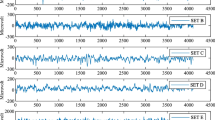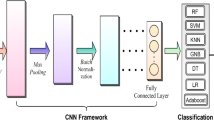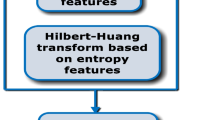Abstract
Today’s hospitals make use of state-of-the-art methods such as magnetic resonance imaging (MRI) and electroencephalogram (EEG) signal predictions in order to predict the occurrence of seizures well in advance. However, this method only works in theory. Almost every standard seizure prediction approach fails to predict epileptic seizures. Accurately, and most doctors mainly focus only on the treatment of epilepsy rather than preventing it. Health experts say that successive epileptic seizures would be even more virulent and fatal to individuals. The motivation of this research is to effectively predict and manage epileptic seizures disease by analyzing EEG signals. This work proposes a new Epileptic Seizures Diagnosis System (ESDS) for diagnosing epileptic seizures effectively. The proposed ESDS consists of two components, namely feature selection and classification. First, a newly proposed Fuzzy Temporal Naïve Bayes (FT-NB) classifier and the existing Convolutional Neural Network with Temporal Features (T-CNN) are proposed for performing effective data preprocessing and classification. Second, a GridSearchCV method is used to determine the best parameter for hyperparameter tuning to obtain the best performance in the FT-NB. In addition, the T-CNN is also applied for enhancing the prediction result further, and the different machine learning (ML) algorithms are considered for performing comparative analysis with the FT-NB in terms of disease prediction. The experiments have been conducted by using the standard dataset and proved as better than other systems in terms of Precision (87.5%), Recall (90.4%), Specificity (97.4%) and Accuracy (96.7%).






Similar content being viewed by others
Availability of data and material
Not Applicable.
Code availability
Not Applicable.
References
Abdellatif A (2015) A new method for predicting epilepsy seizure. In: 2015 IEEE 4th Portuguese Meeting on Bioengineering (ENBENG), Porto, pp 1–4
Almustafa KM (2020) Classification of epileptic seizure dataset using different machine learning algorithms. Inform Med Unlocked 21, Article No.100444:1–7
Antoniades A, Spyrou L, Took CC, Sanei S (2016) Deep learning for epileptic intracranial EEG data. In: 2016 IEEE 26th International Workshop on Machine Learning for Signal Processing (MLSP), Vietrisul Mare, pp 1–6
Anugraha A, Vinotha E, Anusha R, Giridhar S, Narasimhan K (2017) A machine learning application for epileptic seizure detection. In: 2017 International Conference on Computational Intelligence in Data Science (ICCIDS), Chennai, pp 1–4
Cao Y, Guo Y, Yu H, Yu X (2017) Epileptic seizure auto-detection using deep learning method. In: 2017 4th International Conference on Systems and Informatics (ICSAI), Hangzhou, pp 1076–1081
Daoud H, Bayoumi MA (2019) Efficient epileptic seizure prediction based on deep learning. IEEE Trans Biomed Circuits Syst 13(5):804–813
Ganapathy S, Sethukkarasi R, Yogesh P, Vijayakumar P, Kannan A (2014) An intelligent temporal pattern classification system using fuzzy temporal rules and particle swarm optimization. Sadhana 39(2):283–302
Jiang L, Zhang H, Cai Z (2009) A Novel Bayes Model: Hidden Naive Bayes. IEEE Trans Knowl Data Eng 21(10):1361–1371
Kanimozhi U, Ganapathy S, Manjula D, Kannan A (2019) An intelligent risk prediction system for breast Cancer using fuzzy temporal rules. Natl Acad Sci Lett 42(03):227–232
Kumar A, Kolekar MH (2014) Machine learning approach for epileptic seizure detection using wavelet analysis of EEG signals. In: 2014 International Conference on Medical Imaging, m-Health and Emerging Communication Systems (MedCom), Greater Noida, pp 412–416
Lestari FP, Haekal M, Edison RE, Fauzy F r, Khotimah SN, Haryanto F (2020) Epileptic Seizure Detection in EEGs by Using Random Tree Forest, Naive Bayes and KNN Classification. J Phys Conf Ser 1505:012055
Manasvi Bhat K, Anchalia PP, Yashashree S, Sanjeetha R, Kanavalli A (2019) "Detection and Prediction of the Preictal State of an Epileptic Seizure using Machine Learning Techniques on EEG Data," 2019 IEEE Bombay Section Signature Conference (IBSSC), pp. 1–5
Muhammad Usman S, Khalid S, Aslam MH (2020) Epileptic seizures prediction using deep learning techniques. IEEE Access 8:39998–40007
Pariserum Perumal S, Sannasi G, Arputharaj K (2019) An intelligent fuzzy rule-based e-learning recommendation system for dynamic user interests. J Supercomput 75:5145–5160
Pinto MF, Leal A, Lopes F, Dourado A, Martins P, Teixeira CA (2021) A personalized and evolutionary algorithm for interpretable EEG epilepsy seizure prediction. Sci Rep 11:3415
Randon NJ, Lawry J, Horsburgh K, Cluckie ID (2008) Fuzzy Bayesian modeling of sea-level along the East Coast of Britain. IEEE Trans Fuzzy Syst 16(3):725–738
Rasheed K, Qayyum A, Qadir J, Sivathamboo S, Kawn P, Kuhlmann L, Razi A (2021) Machine learning for predicting epileptic seizures using EEG signals: a review. IEEE Rev Biomed Eng 14:139–155
Riyaz B, Ganapathy S (2020) A deep learning approach for effective intrusion detection in wireless networks using CNN. Soft Comput 24:17265–17278
Selim S, Elhinamy E, Othman H, Abouelsaadat W, Salem MA-M (2019) "A Review of Machine Learning Approaches for Epileptic Seizure Prediction," 2019 14th International Conference on Computer Engineering and Systems (ICCES), pp. 239–244
Shirakawa M, Nakayama K, Hara T, Nishio S (2015) Wikipedia-based semantic similarity measurements for Noisy short texts using extended naive Bayes. IEEE Trans Emerg Top Comput 3(2):205–219
Siddiqui MK, Morales-Menendez R, Huang X, Hussain N (2020) A review of epileptic seizure detection using machine learning classifiers. Brain Informatics 7(5):1–18
Singh K, Malhotra J (2022) Two-layer LSTM network-based prediction of epileptic seizures using EEG spectral features. Complex Intell Syst 8:2405–2418
Usman SM, Latif S, Beg A (2019) Principle components analysis for seizures prediction using wavelet transform. Int J Adv Appl Sci 6(3):50–55
Usman SM, Usman M, Fong S (2017) Epileptic seizures Prediction using Machine Learning Methods. Comput Math Methods Med 2017, Article ID: 9074759:1–10
Wang S, Ren J, Bai R (2020) A regularized attribute weighting framework for naive Bayes. IEEE Access 8:225639–225649
Wu X, Zhang T, Zhang L, Qiao L (2022) Epileptic seizure prediction using successive variational mode decomposition and transformers deep learning network. Front Neurosci 16(982541):1–15
Yu L, Gan S, Chen Y, He M (2020) Correlation-based weight adjusted naive Bayes. IEEE Access 8:51377–51387
Funding
No Funding for this work.
Author information
Authors and Affiliations
Contributions
P. Srihari has been implemented the work and written the initial level paper.
V. Santosh has been implemented the work and written the initial level paper.
Sannasi Ganapathy finalized the problem and gave guidance to implement the work. Moreover, he has revised the paper from rough draft of the paper and taken care of the revision.
Corresponding author
Ethics declarations
Ethics approval
Not Applicable.
Consent to participate
Not Applicable.
Consent for publication
Not Applicable.
Conflicts of interest/Competing interests.
There is no conflicts of interest.
Additional information
Publisher’s note
Springer Nature remains neutral with regard to jurisdictional claims in published maps and institutional affiliations.
Rights and permissions
Springer Nature or its licensor (e.g. a society or other partner) holds exclusive rights to this article under a publishing agreement with the author(s) or other rightsholder(s); author self-archiving of the accepted manuscript version of this article is solely governed by the terms of such publishing agreement and applicable law.
About this article
Cite this article
Srihari, P., Santosh, V. & Ganapathy, S. An epileptic seizures diagnosis system using feature selection, fuzzy temporal naive Bayes and T-CNN. Multimed Tools Appl 82, 34075–34094 (2023). https://doi.org/10.1007/s11042-023-14928-7
Received:
Revised:
Accepted:
Published:
Issue Date:
DOI: https://doi.org/10.1007/s11042-023-14928-7




